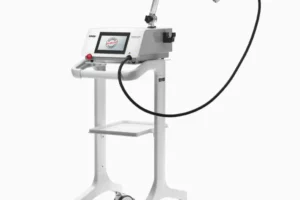[vc_row][vc_column][ultimate_video u_video_url=”https://www.youtube.com/watch?v=fQs3OYBicn8″ yt_autoplay=”” yt_sugg_video=”” yt_mute_control=”” yt_modest_branding=”on” yt_privacy_mode=”” play_size=”75″ enable_sub_bar=””][vc_column_text]
Heel pain is a common condition that can be caused by many factors, including plantar fasciitis and bone spurs.
The good news is that most heel pain responds well to conservative treatment, although it may take several months for symptoms to go away completely. However, if your heel pain doesn’t improve with treatment or continues after you stop your activity, see a foot care professional. On rare occasions and in more serious instances, surgery may be required to resolve your heel pain.[/vc_column_text][vc_column_text]
Heel pain isn’t unusual, however, shouldn’t be ignored.
Although heel pain is common, it’s still important to take care of your feet. If the pain doesn’t go away, or if you have other symptoms, like swelling or redness in your foot, see a specialist right away. Left untreated, heel pain can lead to more serious problems down the road.[/vc_column_text][vc_column_text]
Causes of Heel Pain
[/vc_column_text][vc_column_text]
Sometimes the cause of heel pain is obvious.
One of the most common causes of heel pain is plantar fasciitis, a condition in which the thick band that runs across your foot from your toes to your heel becomes inflamed. Plantar fasciitis is characterised by a stabbing or burning sensation in the bottom of your foot. It’s often worse when you first wake up in the morning and after prolonged periods on your feet — like after work or if you do an activity that involves running and jumping, such as basketball or tennis.
Some people also get heel pain from plantar fasciopathy, a similar condition that causes tissue around their heels to become inflamed and painful over time because of repeated stress on it (such as standing for long periods). A bone spur may develop at the back of one’s heel bone (calcaneus) due to repeated trauma from walking without proper support for arch pain; this can also be called calcaneal spurs, osteophytes (bone spur growths), apophysitis (inflammation), or apophyseal abutment (the attachment point between bones).[/vc_column_text][vc_column_text css=”.vc_custom_1656002841485{margin-top: 30px !important;border-top-width: 1px !important;border-bottom-width: 1px !important;padding-top: 20px !important;padding-bottom: 20px !important;border-top-color: #a60d33 !important;border-top-style: solid !important;border-bottom-color: #a60d33 !important;border-bottom-style: solid !important;}”]Read More: Heel Pain Conditions and Treatments at Active Step[/vc_column_text][vc_column_text]
Sometimes the cause of heel pain isn’t so obvious, and more testing is needed.
Sometimes your pain can be caused by more complex internal issues, such as muscle strain. The muscles in your feet and legs work hard to support you as you walk, run, jump and bend. If the muscles become overworked or injured (like a pulled hamstring), they may not be able to do their job as well as they should. This can lead to plantar fasciitis or a number of other heel ailments.
Pain can also result from muscle imbalance: one leg might be stronger than the other because of poor posture or injury somewhere else in your body—for example, if one hipbone sticks out farther than its counterpart on one side of your body (something called “hip impingement”). Your foot needs both legs working together for proper support; when one leg does all of its work alone it’s like trying to balance yourself on only half a beam—harder for sure![/vc_column_text][vc_column_text]
Treatments for Heel Pain
[/vc_column_text][vc_column_text]There are a lot of treatments for heel pain. Some are more effective than others, and some are better suited to certain conditions or types of pain. Some treatments may even be more suitable for younger people, while others may work better in older patients.
Here are some of the more common treatments that you can do at home:[/vc_column_text][dt_vc_list dividers=”false”]
- Rest your feet as much as possible.
Resting your foot and ankle is important to help reduce pain and swelling. It can also help you heal faster, make it less likely that you will injure it again and prevent future problems. On the other hand, it’s also important not to remove ALL activity from your lifestyle as this can actually have a negative effect on your recovery. - Anti-inflammatory medicines, such as ibuprofen or naproxen, can help ease pain and reduce swelling.
If you have swelling, pain and/or inflammation, taking anti-inflammatory medicines can help. Anti-inflammatory medicines such as ibuprofen or naproxen reduce swelling, pain and inflammation. They also thin your blood to reduce clotting. This can help prevent further damage to your foot as well as improve healing time if you already have a bruise or open wound on the bottom of your foot. - Ice therapy can reduce swelling and help relieve pain.
Applying ice to the affected area can also help to relieve some of the symptoms associated with heel pain, such as swelling & inflammation. Ice should always be applied indirectly to avoid ice burns.Ice therapy is often considered to be a short term fix for immediate pain and may require other forms of treatment alongside it in order to resolve any underlying issue. - Stretching exercises for your foot and calf can release tension that may be contributing to your pain.
If you’re suffering from heel pain, stretching exercises for your foot and calf can help release tension that may be contributing to your pain. Stretching exercises for your foot and calf can also help prevent injury and plantar fasciitis.
[/dt_vc_list][/vc_column][/vc_row][vc_row full_width=”stretch_row” content_placement=”bottom” el_class=”bg-gradient” css=”.vc_custom_1655222385007{margin-top: 20px !important;margin-bottom: 20px !important;}”][vc_column width=”3/4″ css=”.vc_custom_1655220819048{padding-top: 20px !important;padding-bottom: 20px !important;}”][ultimate_heading main_heading=”“For pain relief, the best thing to try initially is isometric exercises; just some nice, controlled bodyweight heel raises and holding those positions on your tippy toes.”” heading_tag=”h3″ alignment=”left” main_heading_style=”font-style:italic;” el_class=”text-light” main_heading_margin=”margin-bottom:30px;” sub_heading_margin=”margin-bottom:50px;”]
– Alice Forward BSc (Hons), Clinical Director
[/ultimate_heading][/vc_column][vc_column width=”1/4″ css=”.vc_custom_1656002246533{margin-bottom: 0px !important;padding-bottom: 0px !important;}” offset=”vc_hidden-xs”][vc_single_image image=”14251″ img_size=”full” css=”.vc_custom_1655225579234{margin-bottom: 0px !important;padding-top: 0px !important;padding-bottom: 0px !important;}”][/vc_column][/vc_row][vc_row css=”.vc_custom_1655833080953{padding-top: 40px !important;padding-bottom: 80px !important;}”][vc_column][vc_column_text]
Get your heel pain assessed professionally
At Active Step, we ensure that each of our patients receive a thorough examination of their feet and lower body, in order to establish the cause of any heel pain they may be experiencing. We then provide personalised recommendations and programmes to support quick and effective pain relief in order to get you back to feeling your best.
If you’re suffering from heel pain or looking for advice on foot care in general, get in touch with our experienced podiatry specialists today.[/vc_column_text][dt_default_button link=”url:https%3A%2F%2Factive-step-healthcare-ltd.au1.cliniko.com%2Fbookings%3Fbusiness_id%3D30903%26appointment_type_id%3D336463|title:Heel%20Pain%20Clinic%20Booking” size=”big” button_alignment=”btn_left”]Book an Expert Heel Pain Consultation[/dt_default_button][/vc_column][/vc_row][vc_row full_width=”stretch_row” equal_height=”yes” bg_type=”bg_color” css=”.vc_custom_1655224217930{margin-right: 0px !important;padding-right: 0px !important;}” bg_color_value=”#2b3685″][vc_column width=”2/5″ css=”.vc_custom_1655224256239{padding-top: 30px !important;padding-bottom: 30px !important;}”][ultimate_heading main_heading=”Give Your Feet an MOT” alignment=”left” el_class=”text-light” main_heading_margin=”margin-bottom:30px;” sub_heading_margin=”margin-bottom:20px;”]Our MSK Assessments offer in-depth analysis of your gait and mobility of the full lower body, giving you a foundation of knowledge to improve your running technique. Our expert podiatrist team will help you meet any mobility goals you have, as well as provide a wealth of resources to improve your foot health and comfort in every situation.[/ultimate_heading][dt_default_button link=”url:https%3A%2F%2Factive-step-healthcare-ltd.au1.cliniko.com%2Fbookings%3Fbusiness_id%3D30903%26appointment_type_id%3D128225|title:MSK%20and%20Gait%20analysis” size=”big” button_alignment=”btn_left”]Book An MSK Appointment[/dt_default_button][/vc_column][vc_column width=”3/5″ css=”.vc_custom_1655224738577{background-position: center !important;background-repeat: no-repeat !important;background-size: cover !important;}”][vc_row_inner][vc_column_inner width=”1/3″][vc_single_image image=”14256″ img_size=”full”][/vc_column_inner][vc_column_inner width=”1/3″][vc_single_image image=”14254″ img_size=”full”][/vc_column_inner][vc_column_inner width=”1/3″][vc_single_image image=”14255″ img_size=”full”][/vc_column_inner][/vc_row_inner][/vc_column][/vc_row]



